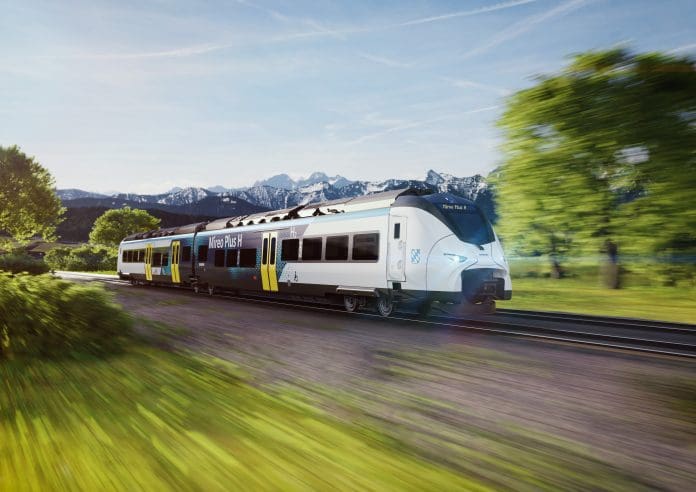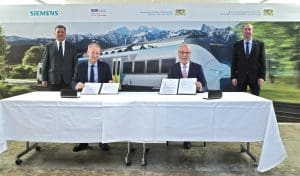
On March 15, Siemens Mobility (Siemens), a separately managed company of Siemens AG, and Bayerische Regiobahn (BRB), a German railway company, signed a leasing contract for a new prototype for Bavaria’s first hydrogen-powered (H2-powered) train. In addition to representatives from the two firms, the contract was signed by Bavaria’s economic affairs minister, Hubert Aiwanger, and Bavaria’s transport minister, Christian Bernreiter. “Green hydrogen is becoming a key pillar for comprehensive climate protection in the areas of transportation, industry, and energy,” said Hubert Aiwanger, Bavaria’s economic affairs minister. “As minister of economic affairs and energy, I am pleased that our Bavarian hydrogen strategy can increasingly address concrete issues. This train is an important part of this strategy toward a ‘transport turnaround’ with hydrogen, which is why we are promoting this project. I am convinced that with green hydrogen propulsions, we can significantly reduce pollutant emissions in heavy-duty and rail transport and contribute to decarbonization. The one-sided dependence on energy supplies can also be reduced and spread across many regions of the world.”

(Image Courtesy Of Siemens Mobility)
Siemens reaffirmed that it plans to present the train to the public in spring 2022. First tests are expected to run along the Augsburg-Füssen route in mid-2023. Pilot testing along BRB’s rail network will continue to take place until passenger service begins in January 2024. “Bayerische Regiobahn sees itself as a reliable mobility partner for the Bavarian public and would like to provide them with climate-friendly service day after day,” said Arnulf Schuchmann, managing director of Bayerische Regiobahn. “We’re also thinking of the future and are happy to be helping set the course for tomorrow’s mobility today. Notwithstanding all the effort associated with the project, we are very much looking forward to the test operations in our rail network and the know-how we gain for using hydrogen technology in the rail sector. Together with the Transdev Group, to which we belong, and our entire on-site team, we will prepare the project in the best possible way in order to ensure a smooth test start next year.”
The Mireo Plus H Platform
The hydrogen-powered train is being developed on Siemens Mobility’s Mireo Plus H platform, which features roof-mounted fuel cells and includes underfloor batteries supplied by Saft, a French battery company. The Mireo Plus H platform comes as a battery-powered unit as well as a conventional electric drive. One of the core goals of Siemens Mobility is to develop alternative drives for rail transport in an effort to decarbonize the transportation industry. “Our Mireo Plus H is the latest-generation hydrogen-powered train,” said Albrecht Neumann, CEO of rolling stock rail solutions at Siemens Mobility. “It features high driving power, excellent acceleration capability, and a large operating range. This will make rail transport faster, more efficient, more eco-friendly, and more comfortable. The hydrogen-powered drive is an emissions-free, advanced form of propulsion for trains that decarbonizes rail transport and makes a substantial contribution toward reaching our climate goals.”
Chugging Along On Schedule
The signing of the contract is a direct follow up to an earlier announcement between Siemens Mobility and the State of Bavaria. In July 2021, Siemens and Bavaria signed a memorandum of understanding (MoU) for a new hydrogen train. The technology partnership is tasked with developing the capabilities of Siemens’ Mireo Plus H Platform. “Our Mireo Plus H is the first prototype that combines the latest hybrid technology consisting of fuel cell and battery with our drive technology in one vehicle and is also the first to be tested in passenger rail service,” said Peter Eckert, team leader for the development of hydrogen hybrid systems at Siemens Mobility, in a statement. “Instead of a pantograph, its power supply is a fuel cell that is fed hydrogen from tanks on the roof. It has a battery that delivers traction power and uses regenerative braking. All this is combined with state-of-the-art technology, integrated on one of today’s most modern and lightest-weight trains. The combination of innovative design and the latest sustainable technology is what makes it so special.”
According to Siemens, the Mireo Plus H Platform supports a hydrogen-powered, two-car train that can run on non-electrified rail lines at a maximum range of nearly 500 miles (804 km). Siemens is in the process of equipping the platform with a new generation of batteries that it hopes will improve performance and enhance the experience for passengers. “In the next-generation H2 propulsion system, the wheels are driven directly — meaning without cardan shafts — by converter-fed induction generators,” said Eckert. “Power is supplied by the high-performance traction battery, which relies on extremely safe, cutting-edge lithium-ion technology and is also designed for regenerative braking. So, the traction battery powers Mireo Plus H’s acceleration processes, whereas the hydrogen system charges the battery and supports the on-board power supply during normal operation at a steady speed.”
Germany’s Growing Hydrogen Economy
Bavaria, which includes major cities like Munich (the location of Siemens’ headquarters) and Nuremburg, is one of several German states that has its own hydrogen goals in addition to broader goals by Germany.
Bavaria has already invested around US$72 million into hydrogen technology, with more than US$55 million in additional funds earmarked for hydrogen infrastructure and applications in the transportation industry. The state’s H2 Hightech Bayern research initiative aims to put Bavaria on the map as a continental leader in sustainable energy production. By 2025, Bavaria hopes that hydrogen will be a key fuel for its overall energy and mobility supply. It plans to install 100 new hydrogen fueling stations by 2025. “I’m really pleased that we’ll soon be able to introduce this innovative technology in Bavaria and test it in regular operation,” said Christian Bernreiter, Bavaria’s transport minister. “We’re working closely with our partners to get this lighthouse project under way because we’re convinced hydrogen propulsion can also contribute to attractive and even climate-neutral passenger rail transport. Our goal is to achieve this by 2040 at the latest. Bavaria’s support of the pilot project with funding of several million euros is more than well-invested.”
Germany is currently the largest global exporter of electrolysis plants. The country accounts for just shy of 20% of electrolyzer exports worldwide. Germany plans to invest around US$10 billion into green hydrogen to increase its total electrolyzer capacity from 5 GW to 10 GW by 2030. The European Commission believes that hydrogen will play a key role in Europe’s push toward net-zero carbon emissions. By 2050, the Commission estimates that 24% of global energy demand could be supplied by clean hydrogen.
In March 2022, Germany updated its carbon neutral goals. It now expects renewable energy to account for 80% of its electricity needs by 2030 and 100% by 2035 compared to a previous goal of 2040. Given escalating tensions in the Russia-Ukraine conflict, Germany is expected to continue to lower its dependence on Russian natural gas by expanding green hydrogen, wind, and solar energy investment, as well as investments into liquefied natural gas.















